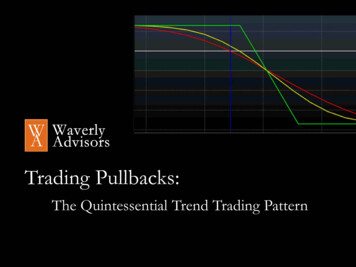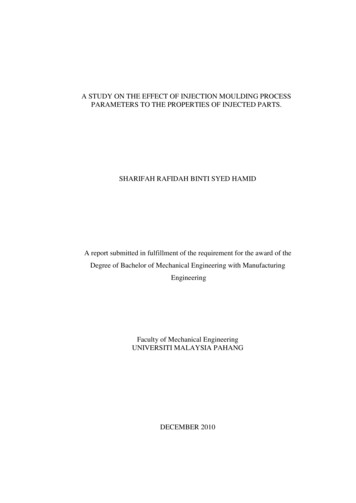
Transcription
Trading Pullbacks:The Quintessential Trend Trading Pattern
Outline Why trade pullbacks? What is a pullback? What are some common variations of pullbacks? How to use pullbacks to read trend strength. A sample trading plan 2013 Waverly Advisors, LLC. The information contained herein is the property of Waverly Advisors which reserves all rights thereto. Redistribution ofany part of this information is prohibited without the express written consent of Waverly Advisors. Waverly Advisors and Macro Playbook, as well as theWaverly Advisors logo, are trademarks of Waverly Advisors, LLC. All rights reserved.
Two Styles of Trading With-Trend Seeks to enter a position in alignment with the preexisting trend, or at thebeginning of a new trend. Common structures are pullbacks and breakouts. Ideal entries are often around “centers”. Counter Trend Looks to take positions against the current dominant trend on the tradingtimeframe. Is there any true countertrend trading? Hope is to be able to capitalize on a shorter trend against the main trend. Trades often center around extremes. 2013 Waverly Advisors, LLC. The information contained herein is the property of Waverly Advisors which reserves all rights thereto. Redistribution ofany part of this information is prohibited without the express written consent of Waverly Advisors. Waverly Advisors and Macro Playbook, as well as theWaverly Advisors logo, are trademarks of Waverly Advisors, LLC. All rights reserved.
Differences Between the Two Styles With-Trend Trades can often be held a long time as trends run—“Ride your winners”. Winners tend to be larger than losers. May reward a more passive mindset. Counter Trend Trades tend to have limited expectation. Important to take profits proactively. Losers are often bigger than winners. Often require aggressive (decisive) psychology. 2013 Waverly Advisors, LLC. The information contained herein is the property of Waverly Advisors which reserves all rights thereto. Redistribution ofany part of this information is prohibited without the express written consent of Waverly Advisors. Waverly Advisors and Macro Playbook, as well as theWaverly Advisors logo, are trademarks of Waverly Advisors, LLC. All rights reserved.
The Pullback Trends tend to move in alternating patterns of with-trend strengthand retracement. The pullback tries to capitalize on this fundamental element of pricebehavior. Uses market structure to limit and define risk. 2013 Waverly Advisors, LLC. The information contained herein is the property of Waverly Advisors which reserves all rights thereto. Redistribution ofany part of this information is prohibited without the express written consent of Waverly Advisors. Waverly Advisors and Macro Playbook, as well as theWaverly Advisors logo, are trademarks of Waverly Advisors, LLC. All rights reserved.
Many names 2013 Waverly Advisors, LLC. The information contained herein is the property of Waverly Advisors which reserves all rights thereto. Redistribution ofany part of this information is prohibited without the express written consent of Waverly Advisors. Waverly Advisors and Macro Playbook, as well as theWaverly Advisors logo, are trademarks of Waverly Advisors, LLC. All rights reserved.
Simplify. Simplify. Simplify All pullback variations are the same and can be traded the same. The market is so random that small variations are not significant. The concept is more important than the details. You are trading pauses in established trends. Simplify as much as possible, but not one bit further. 2013 Waverly Advisors, LLC. The information contained herein is the property of Waverly Advisors which reserves all rights thereto. Redistribution ofany part of this information is prohibited without the express written consent of Waverly Advisors. Waverly Advisors and Macro Playbook, as well as theWaverly Advisors logo, are trademarks of Waverly Advisors, LLC. All rights reserved.
The Key to Technical TradingEvery edge we have comes froman imbalance of buying andselling pressure. 2013 Waverly Advisors, LLC. The information contained herein is the property of Waverly Advisors which reserves all rights thereto. Redistribution ofany part of this information is prohibited without the express written consent of Waverly Advisors. Waverly Advisors and Macro Playbook, as well as theWaverly Advisors logo, are trademarks of Waverly Advisors, LLC. All rights reserved.
Alternation of balance/imbalance 2013 Waverly Advisors, LLC. The information contained herein is the property of Waverly Advisors which reserves all rights thereto. Redistribution ofany part of this information is prohibited without the express written consent of Waverly Advisors. Waverly Advisors and Macro Playbook, as well as theWaverly Advisors logo, are trademarks of Waverly Advisors, LLC. All rights reserved.
Two Basic Pullback Variations 2013 Waverly Advisors, LLC. The information contained herein is the property of Waverly Advisors which reserves all rights thereto. Redistribution ofany part of this information is prohibited without the express written consent of Waverly Advisors. Waverly Advisors and Macro Playbook, as well as theWaverly Advisors logo, are trademarks of Waverly Advisors, LLC. All rights reserved.
Pullbacks 2013 Waverly Advisors, LLC. The information contained herein is the property of Waverly Advisors which reserves all rights thereto. Redistribution ofany part of this information is prohibited without the express written consent of Waverly Advisors. Waverly Advisors and Macro Playbook, as well as theWaverly Advisors logo, are trademarks of Waverly Advisors, LLC. All rights reserved.
Understanding Trend Strength Define swings. Can use pivots and market structure. (See TAAS pp. 15-19) Can also use algorithmic tools. (Pivots, volatility, etc.) Consider each swing in context of previous swings. This price-based approach will lead many indicators. This is only context. Probably not possible to trade market structurelike this on a stop-and-reverse basis. 2013 Waverly Advisors, LLC. The information contained herein is the property of Waverly Advisors which reserves all rights thereto. Redistribution ofany part of this information is prohibited without the express written consent of Waverly Advisors. Waverly Advisors and Macro Playbook, as well as theWaverly Advisors logo, are trademarks of Waverly Advisors, LLC. All rights reserved.
Understanding Trend Strength Uptrend: Upswings are larger than downswings, both in price and time. Downtrend: Downswings are larger than upswings, both in price and time. Pay attention when the pattern changes. Markets in equilibrium do not present clear patterns. 2013 Waverly Advisors, LLC. The information contained herein is the property of Waverly Advisors which reserves all rights thereto. Redistribution ofany part of this information is prohibited without the express written consent of Waverly Advisors. Waverly Advisors and Macro Playbook, as well as theWaverly Advisors logo, are trademarks of Waverly Advisors, LLC. All rights reserved.
Trend Analysis (1/3) 2013 Waverly Advisors, LLC. The information contained herein is the property of Waverly Advisors which reserves all rights thereto. Redistribution ofany part of this information is prohibited without the express written consent of Waverly Advisors. Waverly Advisors and Macro Playbook, as well as theWaverly Advisors logo, are trademarks of Waverly Advisors, LLC. All rights reserved.
Trend Analysis (2/3) 2013 Waverly Advisors, LLC. The information contained herein is the property of Waverly Advisors which reserves all rights thereto. Redistribution ofany part of this information is prohibited without the express written consent of Waverly Advisors. Waverly Advisors and Macro Playbook, as well as theWaverly Advisors logo, are trademarks of Waverly Advisors, LLC. All rights reserved.
Trend Analysis (3/3) 2013 Waverly Advisors, LLC. The information contained herein is the property of Waverly Advisors which reserves all rights thereto. Redistribution ofany part of this information is prohibited without the express written consent of Waverly Advisors. Waverly Advisors and Macro Playbook, as well as theWaverly Advisors logo, are trademarks of Waverly Advisors, LLC. All rights reserved.
Pullbacks: How to Enter Trades Broadly speaking, two plans (for long trades): A. Buy failure tests near the bottom of pullbacks B. Buy breakouts after a pullback These two plans offer a tradeoff between trade location andconfirmation. 2013 Waverly Advisors, LLC. The information contained herein is the property of Waverly Advisors which reserves all rights thereto. Redistribution ofany part of this information is prohibited without the express written consent of Waverly Advisors. Waverly Advisors and Macro Playbook, as well as theWaverly Advisors logo, are trademarks of Waverly Advisors, LLC. All rights reserved.
Pullbacks: Stop Placement With any technical trade, the most important thing is knowing whereyou are getting out if you are wrong. Cannot use extremely tight stops (in most cases). Why? In a proper position-sizing plan, there are no low risk trades,but closer stops allow larger positions and closer profit targets. Using support and resistance for stops is problematic because S&Rslope in pullbacks. 2013 Waverly Advisors, LLC. The information contained herein is the property of Waverly Advisors which reserves all rights thereto. Redistribution ofany part of this information is prohibited without the express written consent of Waverly Advisors. Waverly Advisors and Macro Playbook, as well as theWaverly Advisors logo, are trademarks of Waverly Advisors, LLC. All rights reserved.
Stop Placement: Near and Far 2013 Waverly Advisors, LLC. The information contained herein is the property of Waverly Advisors which reserves all rights thereto. Redistribution ofany part of this information is prohibited without the express written consent of Waverly Advisors. Waverly Advisors and Macro Playbook, as well as theWaverly Advisors logo, are trademarks of Waverly Advisors, LLC. All rights reserved.
Pullbacks: Profit Targets To use or not to use? “Trend following” plan might be to simply buy every pullback until the trenddecisively fails. What is wrong with this plan? Using profit targets will lead to more consistency in the bottom line. If using profit targets, two broad categories: Based on risk ratios. E.g., profits at 1 , 2 initial risk Based on market structure 2013 Waverly Advisors, LLC. The information contained herein is the property of Waverly Advisors which reserves all rights thereto. Redistribution ofany part of this information is prohibited without the express written consent of Waverly Advisors. Waverly Advisors and Macro Playbook, as well as theWaverly Advisors logo, are trademarks of Waverly Advisors, LLC. All rights reserved.
Conservative Profit Targets 2013 Waverly Advisors, LLC. The information contained herein is the property of Waverly Advisors which reserves all rights thereto. Redistribution ofany part of this information is prohibited without the express written consent of Waverly Advisors. Waverly Advisors and Macro Playbook, as well as theWaverly Advisors logo, are trademarks of Waverly Advisors, LLC. All rights reserved.
Pullbacks: Managing Trades One of the most important things to understand about any tradingpattern is how they fail. Failed trades can sometimes offer good trades in the other direction.(Less so in the case of pullbacks.) Understanding how patterns fail can let you see pattern failure as ithappens, sometimes limiting losses on losing trades. Common failures: Flat pullbacks Sharp momentum against Failure at first target 2013 Waverly Advisors, LLC. The information contained herein is the property of Waverly Advisors which reserves all rights thereto. Redistribution ofany part of this information is prohibited without the express written consent of Waverly Advisors. Waverly Advisors and Macro Playbook, as well as theWaverly Advisors logo, are trademarks of Waverly Advisors, LLC. All rights reserved.
Pullbacks: Finding the best trades First, be sure the market is actually trending on the relevanttimeframe. The best pullbacks: Follow sharp with-trend momentum Do not come after climaxes Come earlier in trends Stop at “about” half the previous swing 2013 Waverly Advisors, LLC. The information contained herein is the property of Waverly Advisors which reserves all rights thereto. Redistribution ofany part of this information is prohibited without the express written consent of Waverly Advisors. Waverly Advisors and Macro Playbook, as well as theWaverly Advisors logo, are trademarks of Waverly Advisors, LLC. All rights reserved.
A Sample Trading Plan (1/2) Using Keltner Channels andModified Moving Average Convergence-Divergence (MACD): A long setup occurs after sharp momentum: Price goes through the upper Keltner Channel MACD makes a significant new low A long entry occurs: After price pulls back near the EMA On the bar that “hooks” the fast line of the MACDin the direction of the trend. 2013 Waverly Advisors, LLC. The information contained herein is the property of Waverly Advisors which reserves all rights thereto. Redistribution ofany part of this information is prohibited without the express written consent of Waverly Advisors. Waverly Advisors and Macro Playbook, as well as theWaverly Advisors logo, are trademarks of Waverly Advisors, LLC. All rights reserved.
A Sample Trading Plan (2/2) Do not trade after a climax. Initial stop placement: At the point at which the pullback is violated Never moved in the direction of risk Profit targets Take of the position off at 1X and 2X risk. Watch for failure around previous trend extreme. (Examples show 10 minute S&P 500 E-mini fut
Two Styles of Trading With-Trend Seeks to enter a position in alignment with the preexisting trend, or at the beginning of a new trend. Common structures are pullbacks and breakouts. Ideal entries are often around “centers”. Counter Trend Looks to take positions










